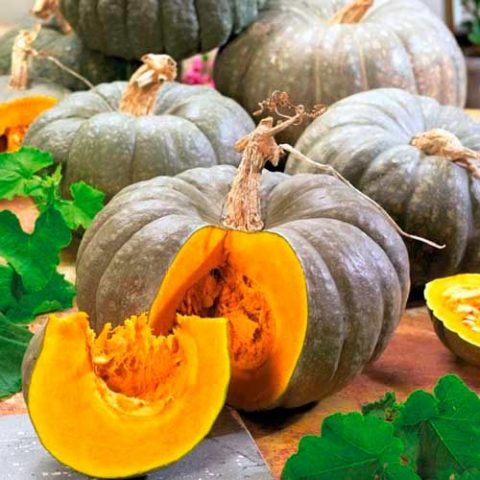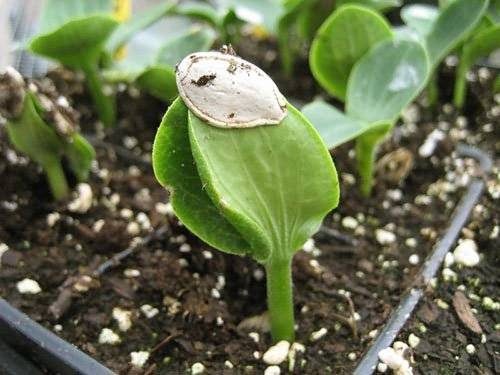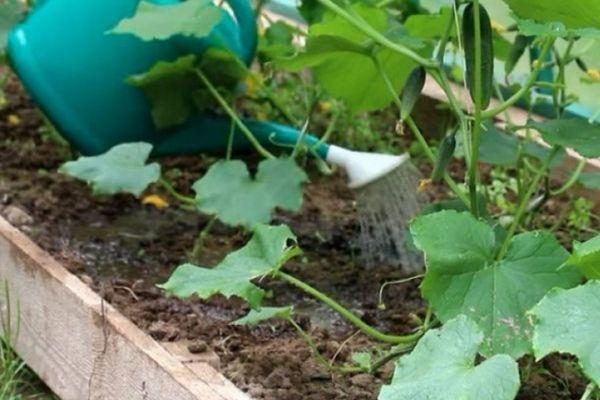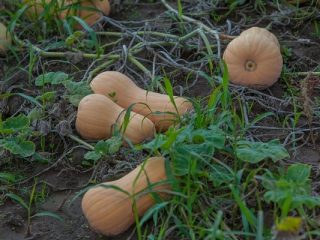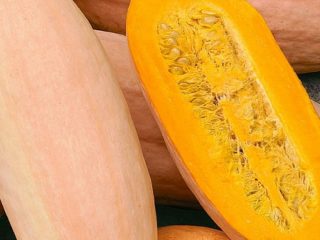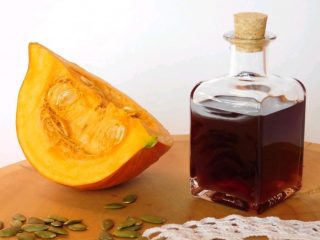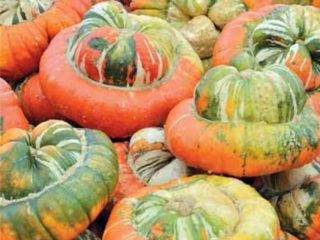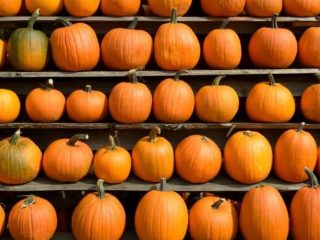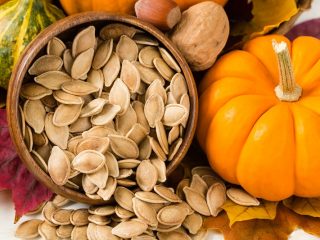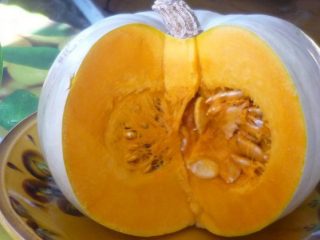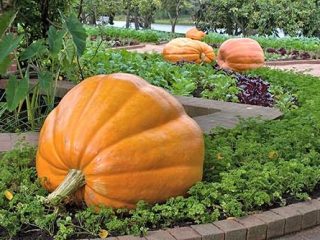Content
Medicinal pumpkin is a variety bred by breeders of the All-Russian Research Institute of Plant Growing in Kuban. In 1994, it was included in the State Register of the Russian Federation and allowed for cultivation. This variety got its name due to the high content of minerals and vitamins in the pulp.
Description of pumpkin Medicinal
Medicinal pumpkin is an annual plant of the pumpkin family. It has short but wide creeping vines, forming a bush of medium thickness. The stems are strong, dense, rounded, rough, without furrows. The plant produces stepsons. The leaves are green, large, not dissected, and have a pentagonal shape.
This is a cross-pollinated, dioecious crop. The flowers are yellow, with five petals, and the ovaries form on pollinated female flowers. The stalk is cylindrical.
Description of fruits
Medicinal pumpkin fruits are round, slightly flattened, and have weak segmentation. The bark is thin, smooth, and easy to clean. In the photo of Medicinal pumpkin you can see several color options for ripe fruits - from uniform grayish-green with longitudinal white stripes to gray, with a pronounced pattern in the form of a dark gray mesh. When cut, it has a greenish-yellow tint. The pulp is light orange, crispy, juicy.The fruits are large, with an average weight of 3 to 6 kg. Gardeners manage to get pumpkins weighing more than 8 kg, as evidenced by photos and reviews on thematic forums dedicated to Medicinal pumpkin. One plant produces 3–5 pumpkins. The fruit has three cavities filled with medium-sized white oval seeds.
Medicinal pumpkin is a universal table variety. Its sweetish pulp is used for making baked goods, cereals, desserts, and juices. Pumpkin baked in the oven is especially delicious.
It is also successfully used in children's nutrition: kids love the rich, sweet taste of the pulp, and parents appreciate the high content of vitamins and nutrients.
This vegetable plays a special role in dietary nutrition. Low calorie content, pleasant taste and exceptional nutritional value are the qualities for which adherents of a healthy diet love pumpkin.
According to the description of the variety, Medicinal pumpkin is rich in vitamins B1, B2 and E, and also contains carotene and fiber. It is believed that it has medicinal properties and helps with vitamin deficiencies and diseases of the gastrointestinal tract.
The beneficial pulp of this variety of pumpkin is included in masks and face creams; it is also used in hair care.
Characteristics of the variety
Medicinal pumpkin is a large-fruited, early-ripening variety. The fruits reach technical maturity on average 95 – 105 days after sowing, although this largely depends on the growing region. The relatively short growing season allows pumpkins of this variety to ripen in short summer conditions.
Despite the fact that pumpkin crops are heat-loving, the Medicinal pumpkin variety is frost-resistant, and grown seedlings can withstand short-term frosts down to -2 °C and sudden temperature changes.
The variety is resistant to short-term drought, but is very responsive to watering.
Productivity depends on growing conditions and climate zone. On average from 1 sq. m harvest from 4 to 6 kg of fruit. From one bush they get about 15 - 20 kg, which corresponds to the indicators of a high-yielding variety.
Medicinal pumpkin has a long shelf life - even at room temperature, the fruits retain all their qualities for up to 10 months.
Resistance to pests and diseases
Medicinal pumpkin is a disease-resistant crop, but it is also susceptible to white and gray rot, powdery mildew, and anthracnose. The best prevention is to observe crop rotation: you should not grow pumpkin on soils where other pumpkin crops previously grew. Another way to increase immunity is to soak planting material in a weak solution of potassium permanganate.
The most common pests are aphids and spider mites. Plants should be inspected regularly for signs of disease or pests. The affected parts are immediately destroyed, and the plantings are treated with appropriate preparations. To control pests, it is enough to use a solution of laundry soap with ash or an infusion of onion peels.
Advantages and disadvantages
Both amateur vegetable growers and farmers highly value this variety for the following qualities:
- cold resistance, resistance to temperature changes;
- unpretentiousness;
- high productivity;
- excellent sweet taste and exceptional nutritional value;
- compactness of the plant;
- keeping quality.
However, like other varieties, Medicinal pumpkin has disadvantages:
- weak resistance to some diseases;
- demands on the soil.
Growing Medicinal Pumpkin
Growing Medicinal pumpkin does not require much effort: even a beginner can cope with planting and caring for it. Depending on the climatic conditions, the seedling or non-seedling method is chosen.
They begin to sow Medicinal pumpkin for seedlings in April, and grown seedlings and seeds are planted in the soil at the end of May - the first half of June, when the soil at a depth of 10–12 cm warms up to at least +12 °C. For seedlings this corresponds to the age of 1 month. By this time, the young plant already has 2–3 true leaves. It is recommended to preheat the planting material. 2 months before the expected sowing date, a paper bag with seeds is placed in a warm place, for example, next to a radiator. It is believed that this promotes the formation of female flowers on plants, on which fruits are set. Immediately before sowing, the seeds must be soaked in a weak solution of potassium permanganate, then germinate in a damp cloth for 24 hours and sown in individual cups to a depth of 5–6 cm. Newly sown seeds must be watered and covered with film, since they need a moist environment for germination.
Young plants planted in a permanent place are mulched. This will help save water and protect plantings from weed. You should also shade the seedlings for 3–5 days.
Medicinal pumpkin can grow on almost any soil, but light loamy and sandy loam soils are best suited for it. It is often planted on compost heaps, but it must be kept in mind that the plant greatly depletes the substrate.
The best precursors for this vegetable are potatoes, onions, tomatoes, cabbage, since these crops do not have diseases and pests in common with it. It is not recommended to plant pumpkin after zucchini, squash, and cucumbers.
Since this variety of pumpkin bush does not form long vines, when planting using the square-cluster method, it is enough to maintain a 60x80 cm pattern. When sowing a crop directly in open ground, at least 3 seeds are placed in the planting hole, of which the strongest sprout is left. The remaining plants are pruned.
Water the plantings as the top layer of soil dries. In this case, waterlogging should be avoided so that rot does not appear on the plants. During the period of flowering and fruit set, the amount of water for each plant is increased. During ripening, watering is reduced - so the pulp will be more sugary.
Mandatory work also includes weeding and loosening. In addition, pumpkin is fed several times a season with organic fertilizers and mineral complexes.
To increase the yield, the side shoots are pinched, and after several fruits have set, the main stem is pinched.
Harvest from July to October. Pumpkins are trimmed, leaving a small stalk. In a cool, dark place, the fruits keep well until May.
Conclusion
Medicinal pumpkin is a variety that is popular among vegetable growers.Its early ripening, cold resistance and unpretentiousness are especially in demand in the short cold summer of the northern regions of Russia, and its excellent taste, nutritional value and exceptional benefits are finding more and more connoisseurs among people who follow proper nutrition.
